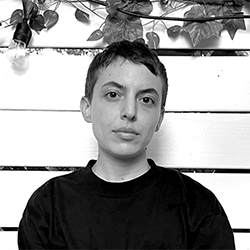Untitled
minimal sense that beings are, oil on canvas, October 2019 [ Grey essay ]
I watched, from the shower floor, L. wash himself. Or, from the position of a stricken eagerness,
a putrid bloating awareness, that results from a combined misery of betrayal and immediate massive caesura that is the beginnings of inverting anything locable that would maintain the moral stance of having been betrayed.
I sat on the shower floor. From this position, I watched L. wash himself.
Perhaps it was not stricken eagerness of having been betrayed, downdrafts of embarrassment stimulating vigil, but consequential, incredulous strains of tamping-disavowal, something more active than denial, that led to a period of months in which my brain, like an idly receptive camera screen set on an overbright room, variously focused glitchy mists. Things occasionally pulsed as recognition—ideas, persons. Then nothing.
My memories that are most sensorially faceted unfortunately are ones in which lucidity was motivated by overwhelming fear. The rainbowic suds that marbled L.’s concave asscheek and formed raspberry-like bubble clusters in his thin bronze hairs. Milder occasions—shadow lights
that get caught around my ceiling beams, indigo shampoo bottles clustering my shower
window—aren’t so crescive.
Why think of syntax? Emmanuel Levinas, in On Escape, does not write that one’s linguistic
status—self as textual ‘I’—produces need for excédence. Yet, Eugenie Brinkema rewrites
Levinas’s assertion of the need to escape as a radical suffering to-not-be-where-(what)-one-is. Could the –where-(what)- of Brinkema’s paraphrase betray being ‘one’ as linguistic bearing, acute and committing? Yet in this, there is—even by I’s striated willingness to remain—a knowing, from syntagmatic calyx or quick, of something less (or not of need).
I wonder if this insistent alignment of agency and visuality could loosen. Attended by that happy
red glare. If letters are the bodily extension that simply cannot be said to belong to any one person, it is a delusion to think they could be used to dominate. Or is this what they’re meant for?

TWOMBLY’S CATULLUS LOOKS AS THE FOGS OF ENCHANTMENT
I don’t experience myself as a continuous subject but I do continuously experience pain.
Pain is reliable, but frustratingly solicitous.
Submissiveness is a shorthand for openness to pain. One wants to work against passive
obedience. The [toxic] [belittling] faithfulness of imperviousness, the strata of unfelt
[self-made]. Can another supersede my relation to my own pain by surpassing it in
intensity?
People don’t understand the difficulty involved in abstraction; they say, my child could do
that, because it’s an unfamiliar or unapparent kind of labor—using a brush so it doesn’t
leave its trace behind.
Glitchiness isn’t opposed to consistency; glitch affirms underlying simplicity (a grid)
whelmed by the front of dimensionality.
Retinal hysteresis. No longer a question of where to look but how.
ON CHEAP BACKDROPS MY STUDIO RENTED FOR A PRODUCTION OF SLEEPING BEAUTY
Painterly suppression of muscle flexions toward writerly conveyance produces
afterburn—both acts commit disregard for as dependence on surface contact; a tension
that permits attention to the instant a brushstroke grafts, visibly emitting, the dense
eroticism of the concept:
one registers (imitating the properties of the canvas) the modulating application of
pressure together with a line’s control of planar disclosure. Presentiment: forceful
insertion of vantage such that a next word seems my shadow afore.
The shape of erasure’s act, as if to protect against subsumption by the reading eye (of
erasing a word), looks nearer, as a scrim, its opacity paradoxically amplifying a being
there of the word.
A vanishing madeness of the mark (transparency) is essential to effect vibrancy.
Twombly’s finger’s compression of tone, as counterpoint, yields sense of a brush’s
fittedness for—by accommodating or incorporating the surface’s impress (its
unresponsiveness, slight solidity)—representational thoroughness in light pressure,
gliding.
The suction of tone sublimated by unprimed canvas disturbs inclinations to coax
representational scenes, can make time pool.
…
Bream nests, conferva. ? Woke up — (sweat behind knees,
shirt collar) tried for a while to find Thoreau’s
description of a nest in the crossbeams, I remember
a segment of an inexistent, ineffectually coerce a shape
as a psychical wound, not as infarction to vision
bare rafters once motivated a footnote
for Thoreau: How it is Night — in Nest and Kennel — And where
was the wood —. Questions shape inhabitance.
I don’t know what I’m saying and feel a little ill. Became meagerly (or medially?)
satisfied with the notion of (re/del-ate as) a doublet
of delay, if simper, . is one of my favorite shadow-shapes, and I apologize for nothing meaning
…
What does staring feel like to you? do you wish you could instead be the floor mat?
The fever, well, I’ve been thinking about variegation
for years, in relation to it, but also that the scallops of fever have metallic undertows.
The fever I feel I often think together with
‘until’ — ‘that nearer every day, until
the agony’ — a soft fabric is being pulled through your hand, what feeling
arises from loosening your grip? The give
E N D N O T E
minimal sense
The painting title, minimal sense that beings are, comes from Eugenie Brinkema’s essay “Violence and the Diagram; Or, The Human Centipede,” in which she writes, regarding the beginning of the titular movie: “Heiter’s opening pronouncement over this image, ‘Good news: Your tissues match,’ is the brute declaration, without history, blank and without provocation (assertive in the strictest sense), that the conjunctive operation is on the order of the possible. This statement of the pure possibility of joining is articulated over the visual self-evidence of the human form as pure presence: beings figured in the barest outlined difference between the figural and the anti-figural. Violence is possible because of this minimal sense that beings are—the constraint on freedom is declared as an event that requires solely what the visual logic avows: that the human form is” (81).
where-(what)-one-is
Again, from Brinkema’s “Violence and the Diagram,” in which she turns to Emmanuel Levinas’s On Escape, she writes: “The Human Centipede is not about escape-to-some-where in this minor sense, but about a different escape altogether: the brutal aspiring only to get out (sortir) (e, 53). Not to elude or flee the house, the doctor, the shit, the terror, but to evade the structure one is itself—not transcendence, but what Levinas dubs excédence. The violence does not produce a need to go somewhere (else) but rather the radical suffering to-not-be-where-(what)-one-is” (88).
happy red glare
This “happy red glare” is borrowed from Johann Geothe’s Theory of Colours, in which he writes: “The French have a happy expression for the less perceptible tendency of yellow and blue towards red: they say the colour has an ‘un oeil de rouge,’ which we might perhaps express by a reddish glance (einen röthlichen blick)” (214).
erasure’s scrim
My poem title references Cy Twombly’s Say goodbye, Catullus, to the shores of Asia Minor, created between 1972-1994. My mention of erasure’s scrim is informed by Roland Barthes’ book on Twombly, Cy Twombly: Fifty Years of Works on Paper, in which he writes: “[Twombly does] not press down, quite the contrary, [his mark] fades away, while retaining the delicate stain of the eraser’s movement; the hand has drawn something like a flower and then begun ‘dawdling’ over this line, the flower has been written, then unwritten; but the two movements remain vaguely superimposed; it is a perverse palimpsest; three texts […] are here, one tending to efface the other, but only, one might say, in order to show that effacement; a veritable philosophy of time” (165).
dense eroticism
My phrase “the dense eroticism of the concept” is informed by Fred Moten’s description of Sigmund Freud’s oeuvre as producing “the dense erotics of arrangement” in his chapter “The Sentimental Avant-Garde” from In the Break: The Aesthetics of the Black Radical Tradition; more fully: “The density of the miniatures that make up the suite we call An Outline of Psycho-Analysis is rich with the necessity and effect of forming pictures in the terrain in which there can be no question. This is the dense erotics of arrangement, the whole of the text working like the whole of the body working like the whole of the orchestra—a miraculously autoexpansive, invaginative, erotogenic zone”(30).
presentiment
My usage of “Presentiment” is informed by Emily Dickinson’s F487A: “Presentiment – is that long / shadow on the Lawn – / Indicative that suns go / down – // the notice to the startled / Grass / that Darkness – is about – / to pass -” (edickinson.org).
thoreauvian nest
Thoreau describes nests and algae across his journals. Here I refer to Thoreau’s description of his ideal home in “House-Warming” from Walden: “I sometimes dream of a larger and more populous house, standing in a golden age, of enduring materials . . . which shall consist only of one room, a vast, rude, substantial, primitive hall, without ceiling or plastering, with bare rafters and purlins supporting a sort of lower heaven over one’s head; . . . where some may live in the fireplace, some in the recess of a window, and some on settles, some at the end of one hall, some at another, and some on rafters with the spiders; . . . a house which you have got into when you have opened the outside door . . . where you can see all the treasures of the house at one view . . .; A house whose inside is as open and manifest as a bird’s nest” (234).
agonic
I also quote the penultimate stanza to Emily Dickinson’s F327A and the opening stanza to F425A: “‘Twas like a Maelstrom, with – / a notch, / That nearer, every Day, / Kept narrowing its boiling / Wheel / Until the Agony” (edickinson.org).
B I B L I O G R A P H Y
Brinkema, Eugenie.“Violence and the Diagram; Or, The Human Centipede.” Qui Parle, vol. 24, no. 2, 2016, pp. 75–108., doi:10.5250/quiparle.24.2.0075.
Dickinson, Emily. F327A, Emily Dickinson Archive, www.edickinson.org.
—. F487A, Emily Dickinson Archive, www.edickinson.org.
Levinas, Emmanuel. On Escape. Stanford University Press, 2003.
Moten, Fred. In the Break: The Aesthetics of the Black Radical Tradition. University of Minnesota Press, 2003.
Thoreau, Henry David. Walden. Yale University Press, 2004.

Ethan Fortuna is a trans writer and visual artist. He is a Postdoctoral Fellow at New York University and received his PhD in Creative Writing and Literature from the University of Houston as a Cynthia Woods Mitchell Center for the Arts Interdisciplinary Fellow. He was selected as a finalist by Wendy’s Subway for the 2023 Carolyn Bush Award book prize, and his work can be found at Southeast Review, TAGVVERK, bæst: a journal of queer forms and affects, Triangle House Review, and elsewhere.

